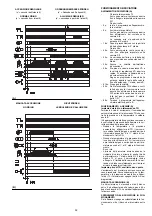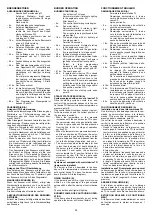
25
EINSTELLUNGEN VOR DER Z†NDUNG
Die Einstellung des Flammkopfs, von Luft und
Gas, ist bereits auf Seite 17 beschrieben worden.
Weitere Einstellungen sind:
-
handbetŠtigte Ventile vor der Gasarmatur šffnen.
-
Den Gas-MindestdruckwŠchter auf den Ska-
lenanfangswert (A) einstellen.
-
Den Luft-DruckwŠchter auf den Skalenan-
fangswert (B) einstellen.
-
Die Luft aus der Gasleitung entlŸften.
Es wird empfohlen, die abgelassene Luft
Ÿber einen Kunststoffschlauch ins Freie
abzufŸhren, bis der Gasgeruch wahrnehm-
bar ist.
-
Ein U Manometer (C) auf den Gasanschlu§
der Muffe einbauen.
Hiermit wird die ungefŠhre Brennerleistung
auf 2. Stufe anhand der Tabellen auf Seite 12
ermittelt.
-
Parallel zu den beiden Gas-Magnetventilen
VR und VS zwei GlŸhbirnen oder einen
Tester anschlie§en, um den Zeitpunkt der
Spannungszufuhr zu ŸberprŸfen.
Dieses Verfahren ist nicht notwendig, falls die
beiden Magnetventile mit einer Kontroll-
lampe ausgestattet sind, die die Elektrospan-
nung anzeigt.
Vor dem ZŸnden des Brenners sind die Gasar-
maturen so einzustellen, da§ die ZŸndung unter
Bedingungen hšchster Sicherheit bei einem
geringen Gasdurchsatz erfolgt.
STELLANTRIEB (D)
†ber den Nocken mit variablem ProÞl steuert
der Stellantrieb gleichzeitig die Luftklappe und
die Gasdrossel. Der Drehwinkel auf dem Stell-
antrieb entspricht dem Winkel auf dem Skalen-
segment der Gasdrossel. Der Stellantrieb fŸhrt
in 12 s eine 90
°
Drehung aus.
Die werkseitige Einstellung seiner 4 Nocken
nicht verŠndern; es sollte nur die Entsprechung
zu folgenden Angaben ŸberprŸft werden:
Nocken St2
: 90
°
Begrenzt die Drehung zum Hšchstwert.
Bei Brennerbetrieb auf 2. Stufe mu§ die Gas-
drossel ganz gešffnet sein: 90
°
.
Nocken St0
: 0
°
Begrenzt die Drehung zum Mindestwert.
Bei ausgeschaltetem Brenner mŸssen die Luft-
klappe und die Gasdrossel geschlossen sein: 0
°
.
Nocken St1
: 15
°
Regelt die ZŸnd- und Leistungsposition auf der
1. Stufe.
Nocken MV
: 85
°
ZŸndet die zweistuÞge LED an (STATUS)
ANFAHREN DES BRENNERS
Die Fernsteuerungen einschalten und:
¥ Schalter 1)(E) in Stellung "Brenner gezŸndet";
¥ Schalter 2)(E) in Stellung "1. STUFE" bringen.
Nach Anfahren des Brenners die Drehrichtung
des GeblŠserades durch das Sichtfenster
18)(A)S. 8 ŸberprŸfen.
Kontrollieren, da§ an den an die Magnetventile
angeschlossenen Kontrollampen und Span-
nungsmessern, oder an den Kontrollampen auf
den Magnetventilen, keine Spannung anliegt.
Wenn Spannung vorhanden ist,
sofort
den
Brenner ausschalten und die Elektroan-
schlŸsse ŸberprŸfen.
Z†NDUNG DES BRENNERS
Wenn alle vorab angefŸhrten Anleitungen
beachtet worden sind, m٤te der Brenner
anfahren.
Wenn hingegen der Motor lŠuft, aber
die Flamme nicht erscheint und eine GerŠte-
Stšrabschaltung erfolgt, entriegeln und das
Anfahren wiederholen.
Sollte die ZŸndung immer noch nicht stattÞnden,
kšnnte dies davon abhŠngen, da§ das Gas
nicht innerhalb der vorbestimmten Sicherheits-
zeit von 3 s den Flammkopf erreicht. In diesem
Fall den Gasdurchsatz bei ZŸndung erhšhen.
Das U-Rohr-Manometer (C) zeigt den Gasein-
tritt an der Muffe an.
Nach erfolgter ZŸndung den Brenner vollstŠndig
einstellen.
ADJUSTMENTS BEFORE FIRST FIRING
Adjustment of the combustion head, and air and
gas deliveries has been illustrated on page 17.
In addition, the following adjustments must also
be made:
-
open manual valves up-line from the gas
train.
-
Adjust the minimum gas pressure switch to
the start of the scale (A).
-
Adjust the air pressure switch to the zero
position of the scale (B).
-
Purge the air from the gas line.
Continue to purge the air (we recommend
using a plastic tube routed outside the build-
ing) until gas is smelt.
-
Fit a U-type manometer (C) to the gas pres-
sure test point on the sleeve.
The manometer readings are used to calcu-
late the 2nd stage operation burner power
using the tables on page 12.
-
Connect two lamps or testers to the two gas
line solenoid valves VR and VS to check the
exact moment at which voltage is supplied.
This operation is unnecessary if each of the
two solenoid valves is equipped with a pilot
light that signals voltage passing through.
Before starting up the burner it is good practice
to adjust the gas train so that ignition takes
place in conditions of maximum safety, i.e. with
gas delivery at the minimum.
SERVOMOTOR (D)
The servomotor provides simultaneous adjust-
ment of the air gate valve, by means of the vari-
able proÞle cam, and the gas butterßy valve.
The angle of rotation of the servomotor is equal
to the angle on the graduated sector controlling
the gas butterßy valve. The servomotor rotates
through 90 degrees in 12 seconds.
Do not alter the factory setting for the 4 cams;
simply check that they are set as indicated
below:
Cams St2
: 90
°
Limits rotation toward maximum position.
When the burner is in 2nd stage operation the
gas butterßy valve must be fully open: 90
°
.
Cams St0
: 0
°
Limits rotation toward the minimum position.
When the burner is shut down the air gate valve
and the gas butterßy valve must be closed: 0
°
.
Cams St1
: 15
°
Adjusts the ignition position and the output in 1st
stage operation.
Cams MV
: 85
°
Lights up the 2nd stage LED (STATUS)
BURNER STARTING
Close the control devices and set:
¥ switch 1)(E) to "Burner ON" position;
¥ switch 2)(E) to "1st STAGE" position.
As soon as the burner starts check the direction
of rotation of the fan blade, looking through the
ßame inspection window 18)(A)p.8.
Make sure that the lamps or testers connected
to the solenoids, or pilot lights on the solenoids
themselves, indicate that no voltage is present.
If voltage is present, then
immediately
stop the
burner and check electrical connections.
BURNER FIRING
Having completed the checks indicated in the
previous heading, the burner should Þre. If the
motor starts but the ßame does not appear and
the control box goes into lock-out, reset and wait
for a new Þring attempt.
If Þring is still not achieved, it may be that gas is
not reaching the combustion head within the
safety time period of 3 seconds.
In this case increase gas Þring delivery.
The arrival of gas at the sleeve is indicated by
the U-type manometer (C).
Once the burner has Þred, now proceed with
global calibration operations.
REGLAGES AVANT L'ALLUMAGE
Le rŽglage de la t•te de combustion, air et gaz,
a dŽjˆ ŽtŽ dŽcrit page 17.
Les autres rŽglages ˆ effectuer sont les sui-
vants:
-
ouvrir les vannes manuelles situŽes en
amont de la rampe du gaz.
-
RŽgler le pressostat de seuil minimum gaz
en dŽbut d'Žchelle (A).
-
RŽgler le pressostat air en dŽbut d'Žchelle (B).
-
Purger le conduit gaz de l'air.
Il est conseillŽ d'Žvacuer l'air purgŽ en
dehors des locaux par un tuyau en plastique
jusqu'ˆ ce que l'on sente l'odeur caractŽristi-
que du gaz.
-
Monter un manom•tre en U (C) sur la prise
de pression de gaz du manchon.
Celui-ci servira ˆ mesurer approximative-
ment la puissance du bržleur en 2•me allure
ˆ l'aide du tableau page 12.
-
Raccorder en parall•le aux deux Žlectrovan-
nes de gaz VR et VS deux lampes ou tes-
teurs pour contr™ler le moment de la mise
sous tension.
Cette opŽration n'est pas nŽcessaire si cha-
cune des deux electrovannes est munie d'un
voyant lumineux signalant la tension Žlectri-
que.
Avant d'allumer le bržleur, rŽgler la rampe du
gaz aÞn que l'allumage se fasse dans les condi-
tions de sŽcuritŽ maximum, c'est ˆ dire avec un
dŽbit de gaz tr•s faible.
SERVOMOTEUR (D)
Le servomoteur r•gle en m•me temps le volet
d'air par la came ˆ proÞl variable et la vanne
papillon du gaz. L'angle de rotation sur le servo-
moteur est Žgal ˆ l'angle sur le secteur graduŽ
de la vanne papillon gaz. Le servomoteur pivote
de 90
°
en 12 secondes.
Ne pas modiÞer le rŽglage des 4 cames Žqui-
pant l'appareil effectuŽ en usine. Contr™ler sim-
plement que ces cames soient rŽglŽes comme
suit:
Came St2
: 90
°
Limite la rotation vers le maximum.
Le bržleur fonctionnant en 2•me allure, la vanne
papillon doit •tre ouverte compl•tement: 90
°
.
Came St0
: 0
°
Limite la rotation vers le minimum.
Bržleur Žteint, le volet de l'air et la vanne
papillon doivent •tre fermŽs: 0
°
.
Came St1
: 15
°
R•gle la position d'allumage et de puissance en
1•re allure.
Came MV
: 85
°
Allume le voyant lumineux de la 2•me allure
(STATUS)
DEMARRAGE BRULEUR
Fermer les tŽlŽcommandes et mettre:
¥ l'interrupteur 1)(E) en position "Bržleur allumŽ";
¥ l'interrupteur 2)(E) en position "1•re ALLURE".
D•s que le bržleur dŽmarre contr™ler le sens de
rotation du rotor turbine par le viseur ßamme
18)(A)p.8.
VŽriÞer que les ampoules ou les testeurs rac-
cordŽs aux Žlectrovannes, ou les voyants sur les
Žlectrovannes, indiquent une absence de ten-
sion. S'ils signalent une tension, arr•ter
immŽ-
diatement
le bržleur et contr™ler les
raccordements Žlectriques.
ALLUMAGE BRULEUR
Apr•s avoir effectuŽ les opŽrations dŽcrites au
point prŽcŽdent, le bržleur devrait s'allumer. Si
le moteur dŽmarre mais la ßamme n'appara”t
pas et le bo”tier de contr™le se bloque, rŽarmer
et faire une nouvelle tentative de dŽmarrage.
Si l'allumage ne se fait pas, il se peut que le gaz
n'arrive pas ˆ la t•te de combustion dans le
temps de sŽcuritŽ de 3 s. Dans ce cas augmen-
ter le dŽbit du gaz ˆ l'allumage. L'arrivŽe du gaz
au manchon est mise en Žvidence par le mano-
m•tre en U (C).
Quand l'allumage est fait, passer au rŽglage
complet du bržleur.
















































